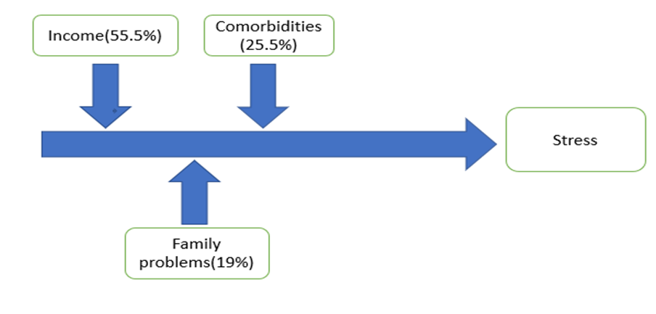


Journal of Clinical and Biomedical Sciences
DOI: 10.58739/jcbs/v13i2.23.17
Year: 2023, Volume: 13, Issue: 2, Pages: 44-49
Original Article
Anandu S1,*, Wasim Anjum2
1 Postgraduate, Department of Community Medicine, SDUMC, Kolar, Karnataka, India
2 Associate Professor, Department of Community Medicine, SDUMC, Kolar, Karnataka, India
*Corresponding author email: [email protected]
Received Date:30 November -0001, Accepted Date:10 June 2023, Published Date:12 July 2023
Growing stress in the developing world is a sign of unresolved physical and emotional tensions. Chronic stress has a detrimental effect on one's health and well-being. The data regarding the levels of perceived stress and its related factors among general population of India is sparse. To assess the perceived stress levels and their related factors among the urban population of Gandhinagar. Data collection was from the residents of Urban field practice area of Gandhinagar, Kolar. A pretested semi-structured questionnaire has been used for the data collection. The houses were chosen using systematic random selection. Study design was a community-based Cross-sectional study. PSS-10 scale was applied to estimate the perceived stress. The research was conducted between October 2022 to February 2023 after getting the clearance from institutional ethics committee. Based on the prevalence of any mental health disorders in India as per National Mental Health Survey (2015-2016) as 10% with alpha error of 5% with 95% confidence interval the minimum sample size calculated was 144 [calculated by Open Epi version 3.01]. For this study, households served as the sample unit. All data was inserted in Microsoft office excel sheet, investigated by SPSS v 22 (IBM Corp). The t-test and the “ANOVA test”, with significance level being defined as “p < 0.05”, was used to find out whether there was significant mean difference between 2 or more groups in perceived stress. Linear regression was performed to find out how much the various factors can predict the perceived stress scores. The univariate analysis showed that habits of smoking, alcoholism, occupation, and socioeconomic status were the factors which can predict the perceived stress levels. When multiple linear regression was done, only the SES was predicting the perceived stress levels. Higher the SES lesser the perceived stress levels. Perceived stress in low socioeconomic status was high with habit of smoking, alcoholism, marital status, and occupation being its covariates. Future research must evaluate the social networks' role in Indian environment as a means of dealing with perceived stress.
Keywords: Perceived stress, Urban Population, PSS10 scale
This is an open-access article distributed under the terms of the Creative Commons Attribution License, which permits unrestricted use, distribution, and reproduction in any medium, provided the original author and source are credited.
Published By Sri Devaraj Urs Academy of Higher Education, Kolar, Karnataka
Subscribe now for latest articles and news.